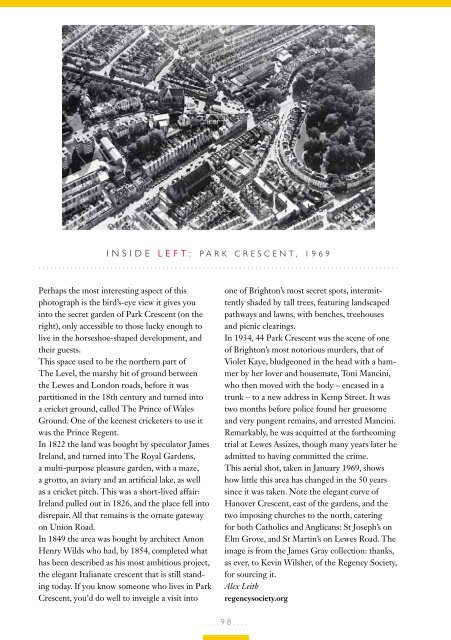Viva Brighton Issue #77 July 2019
Create successful ePaper yourself
Turn your PDF publications into a flip-book with our unique Google optimized e-Paper software.
INSIDE LEFT: PARK CRESCENT, 1969<br />
..........................................................................................<br />
Perhaps the most interesting aspect of this<br />
photograph is the bird’s-eye view it gives you<br />
into the secret garden of Park Crescent (on the<br />
right), only accessible to those lucky enough to<br />
live in the horseshoe-shaped development, and<br />
their guests.<br />
This space used to be the northern part of<br />
The Level, the marshy bit of ground between<br />
the Lewes and London roads, before it was<br />
partitioned in the 18th century and turned into<br />
a cricket ground, called The Prince of Wales<br />
Ground. One of the keenest cricketers to use it<br />
was the Prince Regent.<br />
In 1822 the land was bought by speculator James<br />
Ireland, and turned into The Royal Gardens,<br />
a multi-purpose pleasure garden, with a maze,<br />
a grotto, an aviary and an artificial lake, as well<br />
as a cricket pitch. This was a short-lived affair:<br />
Ireland pulled out in 1826, and the place fell into<br />
disrepair. All that remains is the ornate gateway<br />
on Union Road.<br />
In 1849 the area was bought by architect Amon<br />
Henry Wilds who had, by 1854, completed what<br />
has been described as his most ambitious project,<br />
the elegant Italianate crescent that is still standing<br />
today. If you know someone who lives in Park<br />
Crescent, you’d do well to inveigle a visit into<br />
one of <strong>Brighton</strong>’s most secret spots, intermittently<br />
shaded by tall trees, featuring landscaped<br />
pathways and lawns, with benches, treehouses<br />
and picnic clearings.<br />
In 1934, 44 Park Crescent was the scene of one<br />
of <strong>Brighton</strong>’s most notorious murders, that of<br />
Violet Kaye, bludgeoned in the head with a hammer<br />
by her lover and housemate, Toni Mancini,<br />
who then moved with the body – encased in a<br />
trunk – to a new address in Kemp Street. It was<br />
two months before police found her gruesome<br />
and very pungent remains, and arrested Mancini.<br />
Remarkably, he was acquitted at the forthcoming<br />
trial at Lewes Assizes, though many years later he<br />
admitted to having committed the crime.<br />
This aerial shot, taken in January 1969, shows<br />
how little this area has changed in the 50 years<br />
since it was taken. Note the elegant curve of<br />
Hanover Crescent, east of the gardens, and the<br />
two imposing churches to the north, catering<br />
for both Catholics and Anglicans: St Joseph’s on<br />
Elm Grove, and St Martin’s on Lewes Road. The<br />
image is from the James Gray collection: thanks,<br />
as ever, to Kevin Wilsher, of the Regency Society,<br />
for sourcing it.<br />
Alex Leith<br />
regencysociety.org<br />
....98....


















